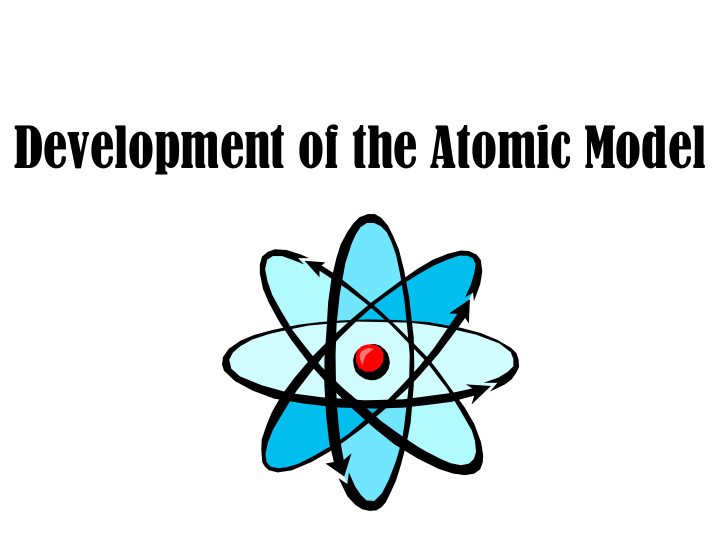



Development of the Atomic Model
6 Major Contributors to the Atomic Model Theory 1. The Greeks 2. Dalton 3. Thomson’s Plum Pudding 4. Rutherford’s Gold -Foil Experiment 5. Bohr’s Planetary Model 6. Chadwick’s Quantum Mechanical
The Greeks (430 BCE) Long long ago, the Greeks believed that everything was made of atoms and that all atoms were identical. They believed that matter was formed of small pieces that could not be cut into smaller parts. Used the word atomos which means “uncuttable”.
“The ancient Greeks did not prove the existence of atoms because they did not do experiments. In science, ideas are just ideas unless they can be tested. The idea of atoms began to develop again in the 1600’s. This time, however, people did do experiments. As a result, atomic theory began to take shape. Atomic theory grew as a series of models that developed from experimental evidence. As more evidence was collected, the theory and models were revised.”
John Dalton (early 1800’s) - All elements are composed of atoms that cannot be divided. - All atoms of the same element are exactly alike and have the same mass. Atoms of different elements are different and have different masses. - An atom of one element cannot be changed into an atom of a different element. Atoms cannot be created or destroyed in any chemical change (or reaction), only rearranged. - Dalton thought that atoms were like smooth, hard balls that could not be broken into smaller pieces. - With only a few changes, Dalton’s atomic theory is still accepted today.
Thomson’s Plum Pudding Model (1897) Protons & electrons are randomly spread throughout the atom (like plums in pudding, apparently… think of raisin bran cereal - it’s all mixed together). Atoms do not contain a nucleus. “Thomson described an atom that consisted of negative charges scattered throughout a ball of positive charge. The negatively charged particles later became known as electrons .”
Rutherford’s Gold Foil Experiment (1911) Through his experiment (aiming a beam of positively charged particles at a thin sheet of gold foil), Rutherford discovered that most of the mass of an atom is in the nucleus and that the rest of the atom is empty space
Niels Bohr’s Planetary Model (1913) Niels Bohr was a student of both Thomson & Rutherford. Bohr theorized that the electrons are in fixed energy levels that orbit around the nucleus. ** Still use this Nucleus model when diagramming an element
Chadwick’s Quantum Mechanical (1932) Current Theory!!! Instead of being in fixed energy levels orbiting the nucleus, the QMT says that the electrons orbit in an electron cloud. “The modern model describes an atom as consisting of a nucleus that contains protons & neutrons, surrounded by a cloudlike region of moving electrons.” (Although when we draw an atomic model, we still use Bohr’s theory in order to see the energy levels)
Recommend
More recommend